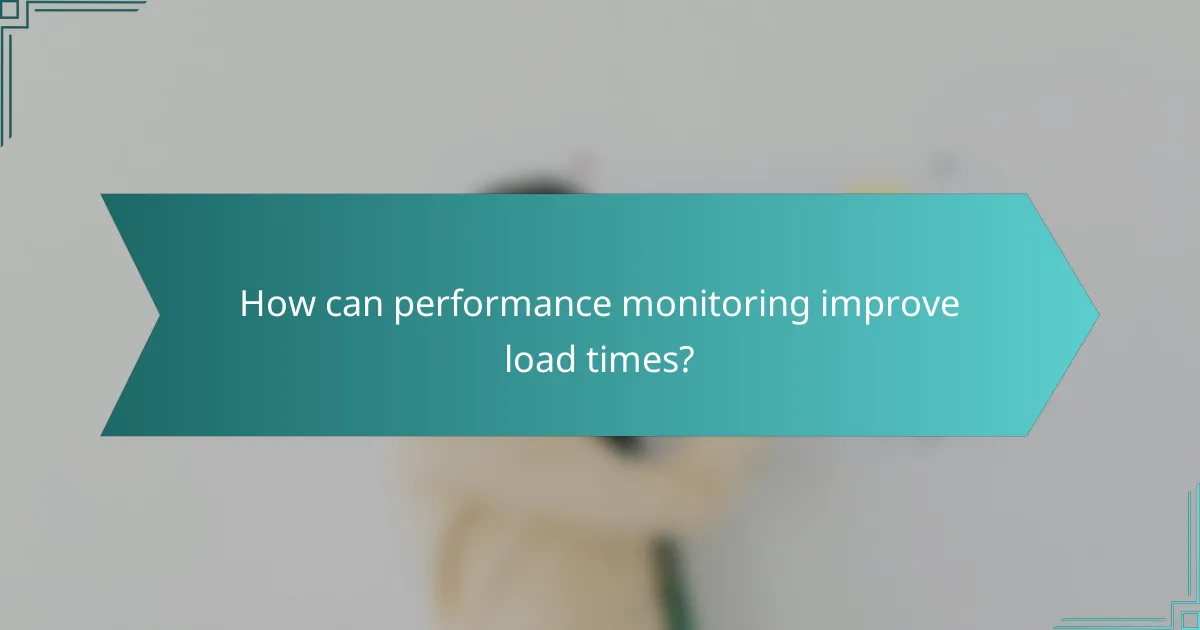Reducing mobile app load times is crucial for enhancing user experience and overall app performance. By implementing strategies such as optimizing images, utilizing lazy loading, and leveraging caching mechanisms, developers can significantly decrease wait times. Additionally, performance monitoring and a well-structured app architecture play vital roles in identifying inefficiencies and streamlining processes for faster load times.

What are the best strategies to reduce mobile app load times?
To effectively reduce mobile app load times, focus on optimizing images, implementing lazy loading, minimizing HTTP requests, utilizing content delivery networks (CDNs), and leveraging caching mechanisms. These strategies can significantly enhance user experience by decreasing wait times and improving app performance.
Optimize images and assets
Optimizing images and other assets is crucial for reducing load times. Use formats like WebP or JPEG 2000 that provide better compression without sacrificing quality. Aim for image sizes under 100 KB whenever possible to ensure quick loading.
Additionally, consider using responsive images that adjust to different screen sizes, which can further enhance performance. Tools like ImageOptim or TinyPNG can help automate this process.
Implement lazy loading techniques
Lazy loading defers the loading of non-essential resources until they are needed, which can drastically improve initial load times. For instance, images and videos can be set to load only when they enter the viewport, reducing the initial data transfer.
Implementing lazy loading can be done using libraries or native browser features. This technique is particularly effective for content-heavy apps, as it allows users to interact with the app while additional resources load in the background.
Minimize HTTP requests
Reducing the number of HTTP requests is vital for faster load times. Combine CSS and JavaScript files where possible to decrease the number of requests made during loading. Aim for fewer than 50 requests for optimal performance.
Consider using CSS sprites for images, which consolidates multiple images into a single file, thus minimizing requests. Tools like Webpack can help automate this process.
Utilize content delivery networks (CDNs)
CDNs distribute your app’s content across various global servers, allowing users to access data from a location closer to them. This reduces latency and improves load times significantly, especially for users in different geographical regions.
Choose a reputable CDN provider that offers good coverage in your target markets. Popular options include Cloudflare and Amazon CloudFront, which can help ensure fast and reliable content delivery.
Leverage caching mechanisms
Caching stores frequently accessed data locally on the user’s device, reducing the need to fetch it from the server repeatedly. Implement strategies like HTTP caching and local storage to enhance performance.
Use cache-control headers to define how long resources should be cached, and consider setting up a versioning system for your assets to manage updates effectively. This can lead to faster load times and a smoother user experience.

How can performance monitoring improve load times?
Performance monitoring can significantly enhance mobile app load times by identifying bottlenecks and inefficiencies in the app’s performance. By continuously tracking key metrics, developers can make informed decisions to optimize loading processes and improve user experience.
Use tools like Google Lighthouse
Google Lighthouse is a powerful tool for measuring the performance of mobile apps. It provides insights into various performance metrics, including load times, accessibility, and best practices. By running audits, developers can pinpoint specific areas needing improvement, such as image optimization or script loading times.
To effectively use Google Lighthouse, run audits regularly during the development cycle. Aim for a performance score above 90, and focus on actionable recommendations provided in the report. Implementing these suggestions can lead to noticeable reductions in load times.
Analyze user behavior with Firebase
Firebase offers robust analytics capabilities that help developers understand how users interact with their mobile apps. By analyzing user behavior, developers can identify patterns that may contribute to slow load times, such as high traffic during specific periods or particular devices experiencing delays.
Utilize Firebase’s real-time analytics to monitor user engagement and performance metrics. Set up alerts for significant drops in performance and correlate these with user activity to identify potential issues. This proactive approach allows for timely optimizations, ensuring a smoother user experience and faster load times.

What role does app architecture play in load times?
App architecture significantly impacts load times by determining how components interact and load data. A well-structured architecture can streamline processes, reduce resource consumption, and enhance user experience by minimizing delays.
Adopt modular app design
Modular app design involves breaking down the application into smaller, independent components. This approach allows developers to load only the necessary modules at startup, which can drastically reduce initial load times. For example, a modular design can enable users to access core functionalities without waiting for the entire app to load.
When implementing modular design, consider using lazy loading techniques to defer the loading of non-essential modules until they are needed. This can lead to faster perceived performance and a smoother user experience. However, ensure that the modules are well-defined and maintainable to avoid complexity in the long run.
Implement asynchronous loading
Asynchronous loading allows different parts of an app to load independently, which can significantly improve load times. By fetching data or resources in the background while the user interacts with the app, you can reduce waiting times and enhance responsiveness. For instance, images or data can be loaded after the main content is displayed, keeping the user engaged.
To effectively implement asynchronous loading, utilize techniques such as AJAX or Promises in JavaScript. Be cautious of potential pitfalls, such as race conditions or excessive requests that could overwhelm the server. A balanced approach ensures that the app remains efficient and user-friendly while optimizing load times.

What are the common pitfalls in mobile app optimization?
Common pitfalls in mobile app optimization include neglecting backend performance and overloading the app with features. These issues can significantly affect load times and overall user experience, leading to higher abandonment rates.
Neglecting backend performance
Backend performance is crucial for mobile app efficiency. A slow server response can lead to delays in data retrieval, causing the app to load slowly. Ensuring that the server can handle user requests efficiently is essential for maintaining optimal load times.
To improve backend performance, consider optimizing database queries and using caching strategies. Implementing a content delivery network (CDN) can also reduce latency by serving content from locations closer to the user.
Overloading the app with features
Overloading an app with too many features can lead to increased complexity and longer load times. Each additional feature requires resources, which can slow down the app’s performance. It’s important to prioritize essential functionalities that enhance user experience.
To avoid feature overload, conduct user research to identify the most valuable features. Regularly review and remove underused functionalities to streamline the app. Aim for a balance between functionality and performance to keep load times minimal.

How do user experience and load times correlate?
User experience and load times are closely linked; faster load times generally lead to a more positive user experience. When an app loads quickly, users are more likely to engage with it, while slow load times can lead to frustration and abandonment.
Impact on user retention rates
Slow load times significantly impact user retention rates. Research indicates that users are likely to abandon an app if it takes longer than a few seconds to load. A reduction in load time by even a second can improve retention by a notable percentage, as users are more inclined to return to an app that performs efficiently.
To enhance retention, consider optimizing images, reducing server response times, and minimizing the use of heavy scripts. Regularly testing load times and gathering user feedback can help identify areas for improvement.
Influence on app store rankings
Load times play a crucial role in determining app store rankings. Both the Apple App Store and Google Play Store consider app performance metrics, including load times, when ranking apps. Apps that load quickly are more likely to receive higher rankings, which can lead to increased visibility and downloads.
To improve your app’s ranking, focus on optimizing performance through techniques like code splitting, lazy loading, and efficient caching strategies. Monitoring performance regularly and addressing any issues promptly can help maintain a competitive edge in app store rankings.

What frameworks can aid in optimizing mobile app performance?
Frameworks like React Native and Flutter are designed to enhance mobile app performance by providing efficient tools and libraries for development. These frameworks help streamline processes, reduce load times, and improve overall user experience through optimized rendering and resource management.
React Native performance tips
To optimize performance in React Native, focus on minimizing unnecessary re-renders by using the shouldComponentUpdate lifecycle method or React.memo for functional components. Additionally, leverage FlatList and SectionList for rendering large lists efficiently, as they only render items that are currently visible on the screen.
Another key strategy is to utilize native modules for performance-intensive tasks. Offloading heavy computations to native code can significantly enhance responsiveness. Regularly profiling your app with tools like the React Native Performance Monitor can help identify bottlenecks and areas for improvement.
Flutter optimization techniques
In Flutter, reducing widget rebuilds is crucial for performance. Use const constructors where possible, and consider the use of the Provider package for state management to avoid unnecessary updates. The Flutter DevTools can help you analyze widget rebuilds and their impact on performance.
Additionally, optimize images and other assets by using the appropriate formats and resolutions. Tools like the Flutter Image package can help manage image loading efficiently. Implementing lazy loading for large datasets can also improve load times and enhance user experience.

What are the emerging trends in mobile app load time reduction?
Emerging trends in mobile app load time reduction focus on leveraging advanced technologies and optimizing user experience. Key strategies include adopting 5G technology, utilizing cloud computing, and implementing efficient coding practices to enhance performance.
Adoption of 5G technology
The adoption of 5G technology significantly improves mobile app load times by providing faster data transfer rates and lower latency. With speeds potentially reaching up to 10 Gbps, users can expect quicker downloads and smoother interactions, which is crucial for data-heavy applications.
When integrating 5G, developers should consider optimizing their apps to take full advantage of the increased bandwidth. This includes compressing images, reducing file sizes, and minimizing the number of server requests. By doing so, apps can load faster even in areas with weaker signals.
It’s essential to test app performance in various network conditions, especially since 5G is still being rolled out globally. Ensuring that your app performs well on both 4G and 5G networks can help maintain a broad user base and enhance overall satisfaction.










